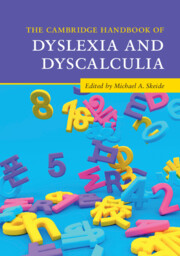Book contents
- The Cambridge Handbook of Dyslexia and Dyscalculia
- The Cambridge Handbook of Dyslexia and Dyscalculia
- Copyright page
- Contents
- Figures and Tables
- Contributors
- Acknowledgements
- General Introduction
- Part I Theoretical Frameworks and Computational Models
- Part II Cognitive Profiles and Behavioural Manifestations
- 4 Cognitive Profiles and Co-occurrence of Dyslexia and Dyscalculia
- 5 Reading and Mathematics Anxiety
- Summary: Cognitive Profiles and Behavioural Manifestations
- Part III Genetic and Environmental Influences
- Part IV Neurodevelopmental Foundations
- Part V Gender, Ethnicity, and Socioeconomic Background
- Part VI Cultural Unity and Diversity
- Part VII Early Prediction
- Part VIII Intervention and Compensation
- Part IX Best Practice – Diagnostics and Prevention
- Part X Best Practice – Schooling and Educational Policy
- General Summary
- References
- Index
- References
5 - Reading and Mathematics Anxiety
from Part II - Cognitive Profiles and Behavioural Manifestations
Published online by Cambridge University Press: 28 July 2022
- The Cambridge Handbook of Dyslexia and Dyscalculia
- The Cambridge Handbook of Dyslexia and Dyscalculia
- Copyright page
- Contents
- Figures and Tables
- Contributors
- Acknowledgements
- General Introduction
- Part I Theoretical Frameworks and Computational Models
- Part II Cognitive Profiles and Behavioural Manifestations
- 4 Cognitive Profiles and Co-occurrence of Dyslexia and Dyscalculia
- 5 Reading and Mathematics Anxiety
- Summary: Cognitive Profiles and Behavioural Manifestations
- Part III Genetic and Environmental Influences
- Part IV Neurodevelopmental Foundations
- Part V Gender, Ethnicity, and Socioeconomic Background
- Part VI Cultural Unity and Diversity
- Part VII Early Prediction
- Part VIII Intervention and Compensation
- Part IX Best Practice – Diagnostics and Prevention
- Part X Best Practice – Schooling and Educational Policy
- General Summary
- References
- Index
- References
Summary
This chapter primarily considers anxiety associated with mathematics and (to a lesser extent) reading. An overview of relevant research in the field can be found in recent review papers on mathematics anxiety (Barroso et al. 2020; Carey, Hill et al. 2017; Chang and Beilock 2016; Dowker et al. 2016; Mammarella et al. 2019; Namkung et al. 2019; Ramirez et al. 2018; J. Zhang et al. 2019) and reading anxiety (Piccolo et al. 2017). Here the focus is on the latest results in the context of some classical research. Emphasis will be laid on large studies that provide more reliable effect size estimates than small, underpowered studies (see Szűcs and Ioannidis 2017 for a review). Specifically, the current chapter relies on international data gathered in the Program for International Student Assessment (Education at a Glance 2018: OECD Indicators, n.d.; OECD 2013), on meta-analyses collating data worldwide, and on specific data sets collected in Belgium, Colombia, Finland, Germany, Israel, India, Italy, the UK, the USA, Poland, and Switzerland.
- Type
- Chapter
- Information
- The Cambridge Handbook of Dyslexia and Dyscalculia , pp. 83 - 97Publisher: Cambridge University PressPrint publication year: 2022
References
Suggestions for Further Reading
- 1
- Cited by

